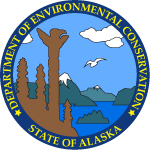| Action Date |
Action |
Description |
DEC Staff |
| 7/1/1985 |
Preliminary Assessment Approved |
(Old R:Base Action Code = SI - Site Investigation). Alaska District conducted site investigations in July 1985 and September 1987. Water, soil, and POL samples were collected in 1985. Environmental and archaeological studies were conducted during both visits. |
Former Staff |
| 7/1/1985 |
Site Added to Database |
Multiple contaminants.
(Date adjusted from 4/3/1992 for report/query consistency. (Reese)) |
Former Staff |
| 4/3/1992 |
Site Ranked Using the AHRM |
Initial ranking. |
Former Staff |
| 6/22/1992 |
Update or Other Action |
(Old R:Base Action Code = SI - Site Investigation). Staff reviewed Pre-Design Final Report dated March, 1992. Report contains previous sampling data and defines regulatory levels for site contaminants. |
Laura Noland |
| 6/24/1992 |
Meeting or Teleconference Held |
Met with Corps of Engineers and USF&WS to establish cleanup levels and cleanup methods for summer of 1993 work. The Corps plan to conduct remediation as they continue to define extend of contamination. |
Laura Noland |
| 9/8/1992 |
Update or Other Action |
(Old R:Base Action Code = RPL2 - Site Information Request Letter). ADEC staff sent PRP-CS Database Notification letter to RP requesting update and more environmental information concerning contaminated site. Jim Levine\COE called 10-5-92 and responded by returning updated DECRPTs. |
Jeff Peterson |
| 4/28/1993 |
Update or Other Action |
(Old R:Base Action Code = CORR - Correspondence (General)). Staff sent ADEC proposed action levels for cleanup at site to E&E's Brian Miskel. |
Marcus Ortelee |
| 5/13/1993 |
Cleanup Level(s) Approved |
(Old R:Base Action Code = CORR - Correspondence (General)). ADEC staff sent a letter to Gail Braten of COE, on action levels for soil and gravel pad cleanup levels. ADEC and USFWS worked together to establish levels based on health and ecological criteria. |
Marcus Ortelee |
| 8/27/1993 |
Update or Other Action |
Proposal document received. |
Bob Couch |
| 3/1/1994 |
Cleanup Plan Approved |
(Old R:Base Action Code = RDRA - Remedial Design / Remedial Action). A removal action awarded for BD/DR and HTRW (DACA85-94-C-0010) and is still underway. |
Former Staff |
| 3/18/1997 |
Update or Other Action |
Site updated by Shannon and Wilson, based on FUDS Site Summary dated 2/21/96. |
Former Staff |
| 5/29/2001 |
Site Characterization Report Approved |
Sent comment letter today on draft removal action report. The report described demolition and site characterization work completed during July 2000. All of the structures were removed and disposed of off-site, surface stained soil was excavated, miscellaneous debris removed. Remaining contamination in sediments and soil. PCBs above 1 mg/kg is of concern along with cumulative risk from multiple VOCs. Comment letter indicated CSM should be completed and cumulative risk calculation should be completed. Concerns exist about a potential dump site at the DEW Line. |
Ann Farris |
| 1/17/2003 |
Update or Other Action |
Staff received Draft No DOD Action Indicated Report today. Review is pending. |
Ann Farris |
| 5/21/2003 |
Site Number Identifier Changed |
Changed Region from 36 to 31. |
Former Staff |
| 8/1/2003 |
Update or Other Action |
Staff changed from Farris to Caillouet |
Debra Caillouet |
| 8/27/2003 |
Update or Other Action |
Staff sent a letter to the Corp requesting additional information. Public comment had been recieved indicating that there may be risk remaining at the site. Until this is resolved DEC can not concur with the NDAI. |
Debra Caillouet |
| 4/12/2004 |
Site Characterization Workplan Approved |
Sampling and Analysis Plan, Post-Remedial Action/Site Restoration Investigation, Collinson Point DEW Line Site was reviewed |
Debra Caillouet |
| 10/14/2004 |
Meeting or Teleconference Held |
Staff attended RAB meeting in Kaktovik |
Debra Caillouet |
| 1/25/2005 |
Meeting or Teleconference Held |
Staff attended RAB meeting in Kaktovik |
Debra Caillouet |
| 3/23/2005 |
Site Characterization Report Approved |
Final Chemical Data Report was received and it incorporated response to comments. The analytical results from this sampling event show bottom sediments from both the Debris Pond and the AST pond are contaminated, as is the surface water in the AST Pond. Additionally, elevated levels of PCBs were found in concrete samples collected from the former Composite Building garage slab. The analytical results for samples collected from the Southwest Pond, Quonset Hut #3, and the surface soils surrounding the former Composite Building garage did not exceed ADEC cleanup criteria. The majority of the debris at Marsh Creek appeared benign, and was likely deposited by storm or ice action. Bottom sediment samples collected from the Debris Pond contained POL above the ADEC soil cleanup levels, as well as PCBs above the NOAA Probable Effects Level; due to the persistent nature of PCBs, it is unlikely that the concentrations of this contaminate will decrease significantly over time. The contaminated sediment in the Debris Pond is covered with a variety of metallic and wooden debris, which will need to be addressed is a removal action is determined to be required to close this site. Bottom sediment samples collected from the AST Pond contained POL above soil cleanup levels as well as low molecular weight PAH above the NOAA Upper Effects Threshold. Analytical results from this pond exceeded groundwater criteria, but no sheen was noted and TAH and TAqH were below 18 AAC 70 levels. Concrete samples from the surface of the former Composite building garage slab continued PCBs above 25 ppm. PCBs in surface soil samples collected from around the slab were below cleanup level, however previous results were above.
Additional remedial/removal efforts may be required for this site, specifically at the Debris Pond, the AST Pond, and the former Composite Building garage slab. Although the landscape may appear blemished due to the presence of rusted 55-gallon drums and drum carcasses littered across the tundra the debris is not eligible for cleanup under FUDS. |
Debra Caillouet |
| 5/3/2005 |
Meeting or Teleconference Held |
Staff attended RAB meeting in Kaktovik |
Debra Caillouet |
| 7/20/2007 |
Update or Other Action |
Staff reviewed and sent comments to the USACE on the draft remedial investigation work plan. |
Debra Caillouet |
| 9/27/2007 |
Update or Other Action |
Staff sent the USACE comment on Rev 1 of the RI work plan |
Debra Caillouet |
| 10/26/2007 |
Site Characterization Workplan Approved |
final comments were addressed |
Debra Caillouet |
| 12/26/2007 |
Update or Other Action |
Staff reviewed the draft remedial investigation report and prepared significant comments. |
Debra Caillouet |
| 6/6/2008 |
Site Characterization Report Approved |
The final remedial investigation report for 2007 was approved. The report documents the use of silica gel cleanup that biased all DR) and RRO results low. The data can be used qualitatively to determine the remedial actions needed. |
Debra Caillouet |
| 12/11/2008 |
Document, Report, or Work plan Review - other |
Staff reviewed and sent major comment to the Corps on the draft RI/FS. |
Debra Caillouet |
| 1/12/2009 |
Site Added to Database |
A new site has been added to the database |
Mitzi Read |
| 2/22/2010 |
Update or Other Action |
The Final Ecoscoping Forms and Ecological Conceptual Site Models, Collinson Point and Nuvagapak Point, DEW Line Stations, February 2010 were received. The ecoscoping indicates the need for a screening level risk assessment. |
Debra Caillouet |
| 7/28/2010 |
Risk Assessment Report Approved |
The Final Preliminary Screening Evaluation and Ecological Conceptual Site Models,
Collinson Point and Nuvagapak Point, DEW Line Stations July 2010 were approved.
Based on the information in these documents ADEC does not believe there is a need
to proceed to an ecological risk assessment. While some of the exceedances if the
ecological screening levels are significant, if the sites are cleaned up to Method
II levels these will be minimized. It is believed that if a full risk assessment
was done, the size of the impacts and the quality of the habitat would demonstrate
that there is no significant ecological risk. |
Debra Caillouet |
| 10/29/2010 |
Document, Report, or Work plan Review - other |
Comments were sent on the Collinson Point Distant Early Warning Line Station, Revised Draft Remedial Investigation/Feasibility Study Report, October 2010 |
Debra Caillouet |
| 7/28/2011 |
CERCLA FS |
Final Remedial Investigation/Feasibility Study Report Collinson Point Distant Early Warning Line Station, Collinson Point Alaska, May 2011 |
Debra Caillouet |
| 5/20/2013 |
CERCLA ROD Approved |
The Composite Building, including the garage, was demolished in 2000, and about 1.7 tons of
petroleum-contaminated soil was excavated from beneath the generator room. Ballasts,
transformers, and capacitors suspected to contain PCBs, POL piping at the east end of the
building, and petroleum-contaminated soil from the vicinity were removed.
In 2000, five soil samples were collected from the area. Two samples contained PCBs at 1.2
mg/kg and 4.4 mg/kg. The remaining analytes were below cleanup levels in the five samples
(EMCON, 2001).
Following demolition, excavation, and sampling, the USACE apparently placed gravel fill
against each side of the Composite Building garage slab flush with the top of the slab to the
surrounding gravel pad. Since the concrete slab was reportedly on-grade and appears to be within
1 foot of the surrounding gravel pad in photographs, a relatively small amount of gravel was
likely placed around the slab.
In 2004, the USACE collected four samples of concrete chipped from the surface of the
Composite Building garage slab. These samples contained PCBs from 4.53 mg/kg to 30.7 mg/kg.
The results were compared to the ADEC soil cleanup level of 1 mg/kg and the report concluded
“additional remedial/removal efforts may be required at the garage slab.”
The Composite Building garage-slab concrete exceeds the 1 mg/kg cleanup level applicable to
bulk PCB remediation waste and porous surfaces in high-occupancy areas, without furtherconditions (ref. TSCA, 40 CFR 761.61(a)(4)(i)(A)). If the procedures and requirements for a low-occupancy area are used, an institutional control such as a deed restriction must be
implemented. The USFWS has stated they would not accept alternatives that depend upon the
integrity of land use controls. The recording of land use restrictions conflicts with the USFWS
agency’s mission. Furthermore, the ADEC requires cleanup of soil and concrete to 1 mg/kg,
unless a cap is placed over the area, maintained, and recorded with a deed notation.
Remediation of the slab is required.
The USACE also collected 10 surface soil samples from the area around the garage slab. These
samples contained up to 0.998 mg/kg PCBs. These results did not exceed the 1 mg/kg ADEC
soil-cleanup level.
Additional remediation is required for soils around the Composite Building. One area is
estimated to be approximately 5 feet by 10 feet, and another about 10 feet by 10 feet, both with
an assumed depth of 3 feet below ground surface (bgs); both will require remedial action to
mitigate risks due to PCBs. This equates to an estimated 17 cubic yards (cy) of in-place PCBcontaminated
soil. The data set suggests a moderate level of uncertainty regarding extent and
volume of PCB-contaminated soil.
PCB soil to be shipped off-site |
Debra Caillouet |
| 5/20/2014 |
Document, Report, or Work plan Review - other |
Draft Work Plan Remedial Action, May 2014 |
Debra Caillouet |
| 7/10/2014 |
CERCLA Remedial Design/Remedial Action Plan Approved |
Final Work Plan, Collinson Point and Nuvagapak Point Remedial Action |
Debra Caillouet |
| 11/23/2015 |
Update or Other Action |
Site management transferred to Carnahan. |
John Carnahan |
| 8/21/2016 |
Update or Other Action |
DEC approves (via email) modifications to workplan to extend the use of the available pad area to within 10 feet of the edge (with adequate berms), and increasing thickness of soil to be treated to 12 inches. DEC also will allow the use of fertilizers to enhance the nutrient viability of the soil if determined appropriate. |
John Carnahan |
| 2/17/2017 |
Document, Report, or Work plan Review - other |
Provided comments on Draft RI Report for multiple sites. |
John Carnahan |
| 5/3/2017 |
Document, Report, or Work plan Review - other |
Provide comments on DRAFT 2017 WP addendum specific to PCB sampling. |
John Carnahan |
| 11/16/2018 |
Document, Report, or Work plan Review - other |
Provide comments on FUDS Closeout Report. |
John Carnahan |
| 1/7/2019 |
Cleanup Complete Determination Issued |
The Alaska Department of Environmental Conservation, Contaminated Sites Program (DEC) has completed a review of the environmental records associated with multiple sites associated with Collinson Point Former Distant Early Warning Station, located at Collinson Point, Alaska. The following sites were closed in the Contaminated Sites database at the Station: 1. Collinson Point DEW Line AST (Aboveground Storage Tank) Pad and AST Pond 2. Collinson Point DEW Line Composite Building Area 3. Collinson Point DEW Line Quonset Hut #3 4. Collinson Point DEW Line Shop Building Area |
John Carnahan |




